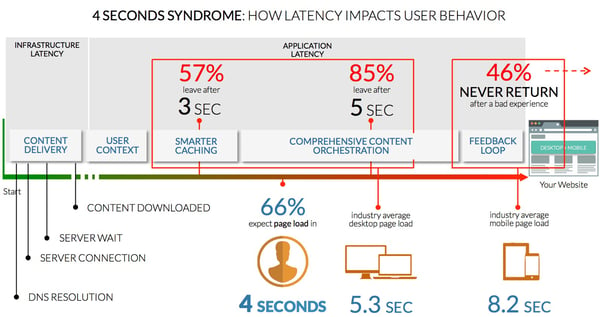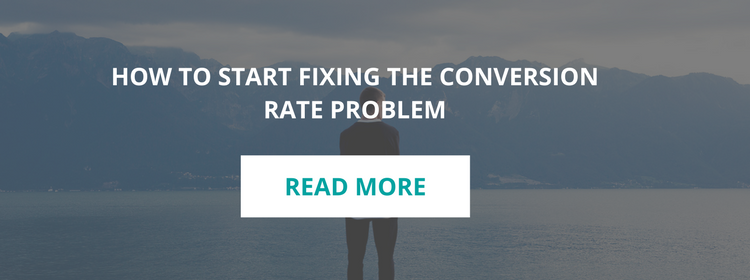Well, I’m here today to tell you that the allegedly tallest Beatle can help you out with that.
Actually, you don’t have to imagine all the people in the world to start fixing the conversion rate problem. But you do need to imagine some of them — your prospects!
Specifically, you need to imagine what their needs are, and put yourself in their shoes. This will help ensure that you can solve your prospects’ problems, as easily as possible.
Doing so will maximise the number of users and conversions on your site, which in turn will maximise your sales.

Ask yourself these three questions to boost your conversion rate:
1. Is your website providing the content your prospects need?
In the world of old-school marketing, providing content on your website mainly meant talking about your company and your products. A lot. There is still a time and a place for that, but these days, it shouldn’t be the first thing you wave at your prospects.
Why? Well, people have changed the way that they make decisions about buying products or services. They use the internet for research — looking up keywords, asking questions, and reading articles and reviews.
The opportunity here is for you to create the content that your prospects are looking for. If your company can be the one to answer their questions, then you can start building a relationship with them and gaining their trust.
In turn, this makes them more likely to use your product or service. After all, don’t you prefer to make a deal with someone you know and have confidence in? This is what we mean by an inbound marketing strategy.
If you don’t have what your prospects are after — they’ll go elsewhere. Research has shown that the average humans’ attention span is eight seconds — less than a goldfish. This means that if your prospects don’t find what they’re after in those eight seconds, they’ll be gone. To your competitor’s site. You can start to establish what content your prospects need by developing customer personas.
According to marketing automation giant HubSpot, a customer persona (or buyer persona) is a ‘semi-fictional representation of your ideal customer, based on market research and real data about your existing customers’
The more detailed you make each persona, the better. Not what they have in their fridge, but who they are and what their needs and problems are. This information will enable you to make sure that your website is giving them information that meets their requirements and helps solve their problems.
As most organisations have different categories of prospects, you may need to develop a buyer persona for each.
You can also use smart content to adjust what individual users see on your site, to keep it as relevant as possible for different buyer personas. Even generic content offers can still be made relevant to separate categories of prospects.
2. Does your website make it easy for prospects to convert?
The internet is a big place. This means that people searching for information or looking for help have options — lots of options. So User Experience (UX in geekspeak) is critical. If your page doesn’t load quickly enough, people will vote with their feet… or at least with their fingers.
Users typically expect a page to load in four seconds, which is faster than the actual average load time (5.3 seconds on a desktop and 8.2 seconds on mobile). If that doesn’t happen, most of them leave:

Image: Yottaa
The user journey on your website is also critical. If it isn’t straightforward, users will bounce off before they convert.
The journey should go from recognising their problems and showing you understand them, to giving options for solutions, showing why you're the best solution and then guiding them to the next step (for example with a call to action button for a relevant guide or case study).
You need to make sure that it's as easy as possible for your prospects to convert. So there needs to be a sufficient number of call to action buttons or links, and they need to be in the right places.
3. Can your prospects find you in the first place?
As mentioned, the internet is more big than small. So you need to maximise your chance of being found in the first place, by making sure that you are where your prospects are.
It’s no good preparing thoughtful content, then just randomly throwing it out onto the internet and hoping it will be found. You need to distribute it intelligently, and find the most strategic places to be. For this, you need a social strategy.
Sounds obvious, but do you actually know which sites or apps your prospects use? Or have you just made assumptions? A proper analysis can be done as part of developing a useful buyer persona. (See 1.)
If your prospects all hang out on LinkedIn, don't waste your time on Twitter. If they all read lennon.org, don’t worry about mccartney.com. That said, you don't have to do every single social platform or website just because they're there. To maximise the impact of your activities and get the best return on your marketing investment (ROMI), focus on the most relevant ones.
Three key takeaways for digital marketers wanting to boost conversion rates
These days, conversion is the main aim of a site. If it doesn’t do that properly, it’s just a waste of space on the internet — harsh but true!
To convert more prospects, you need to put yourself in their shoes. You can do this by:
- Creating buyer personas — consider customer demographics, behaviour patterns, motivations, goals and online preferences
- Ensuring that your website is providing the information that your buyer personas indicate your prospects are after
- Making sure that your content can be found by your prospects in the first place
Do all that, and it’s easier to imagine world peace — at least with your boss.
To find out more about the conversion rate challenges and how to fix them, click the image below.








.png?width=50)

.png?width=50)
.png?width=50)


































